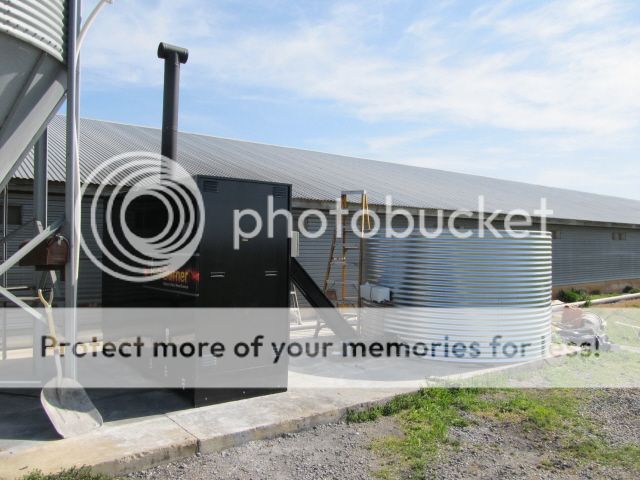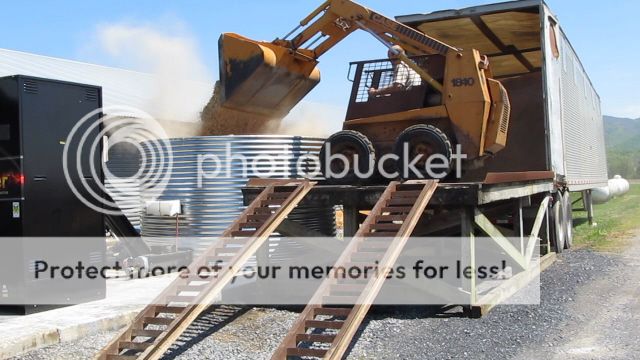My location is north west of Roanoke, VA. Were at the base of a mountain and do get snow and cold nights around 0*. I have seen it get down to -15* a few times during the night with -10* days.
I have triple 350,000 BTU waist oil boiler with a quad 1000 gallon storage tank. This is a unpressurized system.
I'm trying to heat a new building that is 150x30' with 9' ceilings. It has 2x6” walls (R21) with a 2” polystyrene (R10) facing the inside of the building. The ceiling is 2x8” (R25) with 1” (R5) facing down. I know the slab was insulated, but not sure on how it was done. The building needs to stay between 68 and 72*. The building has a few double pain picture windows and a few out side doors. There is a garage door and it's 25x15' with a second garage door to get into the main building. The lighting load is very low.
We also have to raise the temp of all the water we use 20*. We use about 15,000 gallons of water a day. Most of the water flow is during the day. Based on the pump curve it should 35gpm max.
Friday it was low 30's during the day and low 20's during the night. Our back up heat ran part of the day and all night. The building temperature dropped and we suffered some production losses. We knew that we were going to have sizing issues at some point, but hopped it would happen at a much lower outside temperature. There has been lots of different estimates for the heating and cooling loads.
Yesterday and today we have been blowing in 13” (R38) of fiberglass insulation. With 110 bags it took 3 cities to get what we needed, but we got it finished. This gets us over R60 after settling witch is what all the HVAC numbers were based off of.
My HVAC contractor is suggesting we add one more 350,000 unit. I contacted the boiler manufacturer yesterday with the issue. They called me back today and tell me that they re ran all the numbers and “think” we need two more units.
At this point the wife and I are unsure what to do. She just wants to add a single unit, but I would like to add two. I think two would be better in-case one needs parts or that 4 units would give us the needed BTU's. The other thing I keep thinking about is each unit uses about 62 gallons a day at full blast.
I'm wounder on your thoughts.
Dose anyone want to take a guess on the BTU's needed for us?
How much storage do you think we should have?
Dose anyone have any better ideas on heating for us?
I have triple 350,000 BTU waist oil boiler with a quad 1000 gallon storage tank. This is a unpressurized system.
I'm trying to heat a new building that is 150x30' with 9' ceilings. It has 2x6” walls (R21) with a 2” polystyrene (R10) facing the inside of the building. The ceiling is 2x8” (R25) with 1” (R5) facing down. I know the slab was insulated, but not sure on how it was done. The building needs to stay between 68 and 72*. The building has a few double pain picture windows and a few out side doors. There is a garage door and it's 25x15' with a second garage door to get into the main building. The lighting load is very low.
We also have to raise the temp of all the water we use 20*. We use about 15,000 gallons of water a day. Most of the water flow is during the day. Based on the pump curve it should 35gpm max.
Friday it was low 30's during the day and low 20's during the night. Our back up heat ran part of the day and all night. The building temperature dropped and we suffered some production losses. We knew that we were going to have sizing issues at some point, but hopped it would happen at a much lower outside temperature. There has been lots of different estimates for the heating and cooling loads.
Yesterday and today we have been blowing in 13” (R38) of fiberglass insulation. With 110 bags it took 3 cities to get what we needed, but we got it finished. This gets us over R60 after settling witch is what all the HVAC numbers were based off of.
My HVAC contractor is suggesting we add one more 350,000 unit. I contacted the boiler manufacturer yesterday with the issue. They called me back today and tell me that they re ran all the numbers and “think” we need two more units.
At this point the wife and I are unsure what to do. She just wants to add a single unit, but I would like to add two. I think two would be better in-case one needs parts or that 4 units would give us the needed BTU's. The other thing I keep thinking about is each unit uses about 62 gallons a day at full blast.
I'm wounder on your thoughts.
Dose anyone want to take a guess on the BTU's needed for us?
How much storage do you think we should have?
Dose anyone have any better ideas on heating for us?




